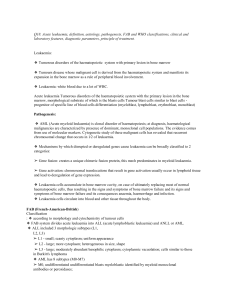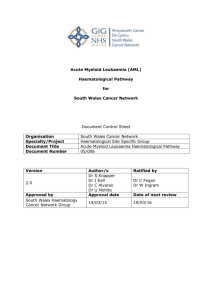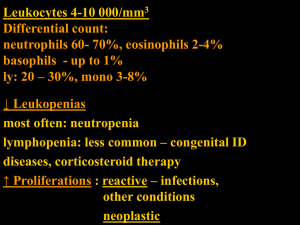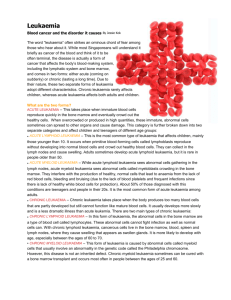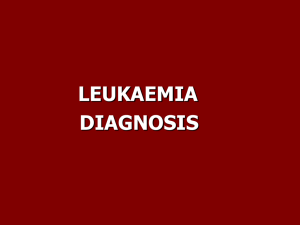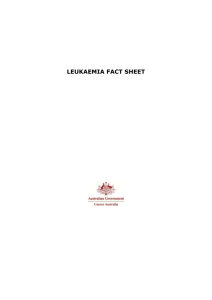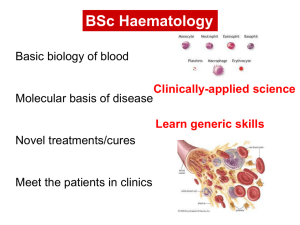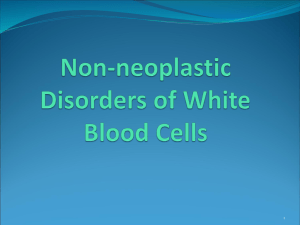pubdoc_12_18322_999
advertisement
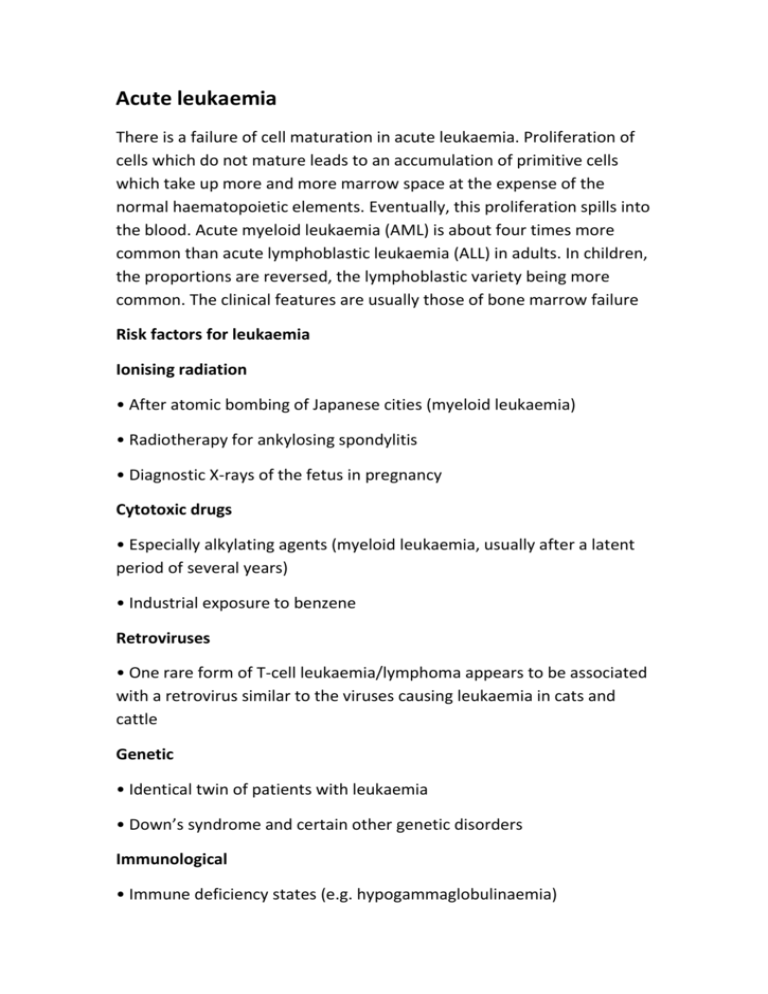
Acute leukaemia There is a failure of cell maturation in acute leukaemia. Proliferation of cells which do not mature leads to an accumulation of primitive cells which take up more and more marrow space at the expense of the normal haematopoietic elements. Eventually, this proliferation spills into the blood. Acute myeloid leukaemia (AML) is about four times more common than acute lymphoblastic leukaemia (ALL) in adults. In children, the proportions are reversed, the lymphoblastic variety being more common. The clinical features are usually those of bone marrow failure Risk factors for leukaemia Ionising radiation • After atomic bombing of Japanese cities (myeloid leukaemia) • Radiotherapy for ankylosing spondylitis • Diagnostic X-rays of the fetus in pregnancy Cytotoxic drugs • Especially alkylating agents (myeloid leukaemia, usually after a latent period of several years) • Industrial exposure to benzene Retroviruses • One rare form of T-cell leukaemia/lymphoma appears to be associated with a retrovirus similar to the viruses causing leukaemia in cats and cattle Genetic • Identical twin of patients with leukaemia • Down’s syndrome and certain other genetic disorders Immunological • Immune deficiency states (e.g. hypogammaglobulinaemia) The diagnosis of leukaemia is usually suspected from an abnormal blood count, often a raised white count, and is confirmed by examination of the bone marrow. This includes the morphology of the abnormal cells, analysis of cell surface markers (immunophenotyping), clone-specific chromosome abnormalities and molecular changes. Terminology and classification Leukaemias are traditionally classified into four main groups: • acute lymphoblastic leukaemia (ALL) • acute myeloid leukaemia (AML) • chronic lymphocytic leukaemia (CLL) • chronic myeloid leukaemia (CML). In acute leukaemia, there is proliferation of primitive stem cells, leading to an accumulation of blasts, predominantly in the bone marrow, which causes bone marrow failure. In chronic leukaemia, the malignant clone is able to differentiate, resulting in an accumulation of more mature cells. Lymphocytic and lymphoblastic cells are those derived from the lymphoid stem cell (B cells and T cells). Myeloid refers to the other lineages: that is, precursors of red cells, granulocytes, monocytes and platelets The diagnosis of leukaemia is usually suspected from an abnormal blood , often a raised white count, and is confirmed by examination of the bone marrow. This includes the morphology of the abnormal cells, analysis of cell surface markers (immunophenotyping), clone-specific chromosome abnormalities and molecular changes. These results are incorporated in the World Health Organization (WHO) classification of tumours of haematopoietic and lymphoid tissues WHO classification of acute leukaemia Acute myeloid leukaemia (AML) with recurrent genetic abnormalities • AML with t(8;21), gene product AML-ETO • AML with eosinophilia inv(16) or t(16;16), gene product CBFβ-MYH11 • Acute promyelocytic leukaemia t(15;17), gene product PML-RARA • AML with t(9;11)(p22;q23), gene product MLLT3-MLL • AML with t(6;9)(p23;q34), gene product DEK-NUP214 • AML with inv(3)(q21q26.2) or t(3;3)(q21;q26.2), gene product RPN1EVI1 Acute myeloid leukaemia with myelodysplasia-related changes • e.g. Following a myelodysplastic syndrome Therapy-related myeloid neoplasms • e.g. Alkylating agent or topoisomerase II inhibitor Myeloid sarcoma Myeloid proliferations related to Down’s syndrome Acute myeloid leukaemia not otherwise specified • e.g. AML with or without differentiation, acute myelomonocytic leukaemia, erythroleukaemia, megakaryoblastic leukaemia, myeloid sarcoma Acute lymphoblastic leukaemia (ALL) • Precursor B ALL • Precursor T ALL Investigations Blood examination usually shows anaemia with a normal or raised MCV. The leucocyte count may vary from as low as 1 × 109/L to as high as 500 × 109/L or more. In the majority of patients, the count is below 100 × 109/L. Severe thrombocytopenia is usual but not invariable. Frequently, blast cells are seen in the blood film but sometimes blast cells may be infrequent or absent. A bone marrow examination will confirm the diagnosis. The bone marrow is usually hypercellular, with replacement of normal elements by leukaemic blast cells in varying degrees (but more than 20% of the cells) . The presence of Auer rods in the cytoplasm of blast cells indicates a myeloblastic type of leukaemia. Classification and prognosis are determined by immunophenotyping, chromosome and molecular analysis, Management The first decision must be whether or not to give specific treatment. This is generally aggressive, has numerous side-effects, and may not be appropriate for the very elderly or patients with serious comorbidities In these patients, supportive treatment can effect considerable improvement in well-being. The aim of treatment is to destroy the leukaemic clone of cells without destroying the residual normal stem cell compartment from which repopulation of the haematopoietic tissues will occur. There are three phases: • Remission induction. In this phase, the bulk of the tumour is destroyed by combination chemotherapy. The patient goes through a period of severe bone marrow hypoplasia, requiring intensive support and inpatient care from a specially trained multidisciplinary team. • Remission consolidation. If remission has been achieved, residual disease is attacked by therapy during the consolidation phase. This consists of a number of courses of chemotherapy, again resulting in periods of marrow hypoplasia. In poor-prognosis leukaemia, this may include haematopoietic stem cell transplantation. • Remission maintenance. If the patient is still in remission after the consolidation phase for ALL, a period of maintenance therapy is given, with the individual as an outpatient and treatment consisting of a repeating cycle of drug administration. This may extend for up to 3 years if relapse does not occur. In patients with ALL, it is necessary to give prophylactic treatment to the central nervous system, as this is a sanctuary site where standard therapy does not penetrate. This usually consists of a combination of cranial irradiation, intrathecal chemotherapy and highdose methotrexate, which crosses the blood– brain barrier. Thereafter, specific therapy is discontinued and the patient observed. In some patients, alternative palliative chemotherapy, not designed to achieve remission, may be used to curb excessive leucocyte proliferation. Drugs used for this purpose include hydroxycarbamide and mercaptopurine. The aim is to reduce the blast count without inducing bone marrow failure. Supportive therapy Aggressive and potentially curative therapy, which involves periods of severe bone marrow failure, would not be possible without appropriate supportive care. The following problems commonly arise. Anaemia. Anaemia is treated with red cell concentrate transfusions. Bleeding. Thrombocytopenic bleeding requires platelet transfusions, unless the bleeding is trivial. Prophylactic platelet transfusion should be given to maintain the platelet count above 10 × 109/L. Coagulation abnormalities occur and need accurate diagnosis and treatment Infection. Fever (> 38°C) lasting over 1 hour in a neutropenic patient indicates possible septicaemia Parenteral broad-spectrum antibiotic therapy is essential. Empirical therapy is given according to local bacteriological resistance patterns: for example, with a combination of an aminoglycoside (e.g. gentamicin) and a broad-spectrum penicillin (e.g. piperacillin/tazobactam) or a single-agent beta-lactam (e.g. meropenem). The organisms most commonly associated with severe neutropenic sepsis are Gram-positive bacteria, such as Staphylococcus aureus and Staph. epidermidis, which are present on the skin and gain entry via cannulae and central lines. Gram-negative infections often originate from the gastrointestinal tract, which is affected by chemotherapy-induced mucositis; organisms such as Escherichia coli, Pseudomonas and Klebsiella spp. are likely to cause rapid clinical deterioration and must be covered with the initial empirical antibiotic therapy. Gram-positive infection may require vancomycin therapy. If fever has not resolved after 3–5 days, empirical antifungal therapy (e.g. a liposomal amphotericin B preparation, voriconazole or caspofungin) is added. Patients with ALL are susceptible to infection with Pneumocystis jirovecii , which causes a severe pneumonia. Prophylaxis with co-trimoxazole is given during chemotherapy. Diagnosis may require either bronchoalveolar lavage or open lung biopsy. Treatment is with high-dose co-trimoxazole, initially intravenously, changing to oral treatment as soon as possible. Oral and pharyngeal candida infection is common. Fluconazole is effective for the treatment of established local infection and for prophylaxis against systemic candidaemia. Prophylaxis against other systemic fungal infections, including Aspergillus, using itraconazole or posaconazole, for example, is usual practice during high-risk intensive chemotherapy. This is often used along with sensitive markers of early fungal infection to guide treatment initiation (a ‘pre-emptive approach’). For systemic fungal infection with Candida or aspergillosis, intravenous liposomal amphotericin or voriconazole is required. Reactivation of herpes simplex infection occurs frequently around the lips and nose during ablative therapy for acute leukaemia, and is treated with aciclovir. This may also be prescribed prophylactically to patients with a history of cold sores or elevated antibody titres to herpes simplex. Herpes zoster manifesting as chickenpox or, after reactivation, as shingles should be treated in the early stage with high-dose aciclovir, as it can be fatal in immunocompromised patients. The value of isolation facilities, such as laminar flow rooms, is debatable but may contribute to staff awareness of careful reverse barrier nursing practice. The isolation can be psychologically stressful for the patient. Metabolic problems. Frequent monitoring of fluid balance and renal, hepatic and haemostatic function is necessary. Patients are often severely anorexic and diarrhea is common as a consequence of the sideeffects of therapy; they may find drinking difficult and hence require intravenous fluids and electrolytes. Renal toxicity occurs with some antibiotics (e.g. aminoglycosides) and antifungal agents (amphotericin). Cellular breakdown during induction therapy (tumour lysis syndrome) releases intracellular ions and nucleic acid breakdown products, causing hyperkalaemia, hyperuricaemia, hyperphosphataemia and hypocalcaemia. This may cause renal failure. Allopurinol and intravenous hydration are given to try to prevent this. In patients at high risk of tumour lysis syndrome, prophylactic rasburicase (a recombinant urate oxidase enzyme) can be used. Occasionally, dialysis may be required. Psychological problems. Psychological support is a key aspect of care. Patients should be kept informed, and their questions answered and fears allayed as far as possible. Haematopoietic stem cell transplantation In patients with high-risk acute leukaemia, allogeneic HSCT can improve 5-year survival from 20% to around 50%. Prognosis Without treatment, the median survival of patients with acute leukaemia is about 5 weeks. This may be extended to a number of months with supportive treatment. Patients who achieve remission with specific therapy have a better outlook. Around 80% of adult patients under 60 years of age with ALL or AML achieve remission, although remission rates are lower for older patients. However, the relapse rate continues to be high.
